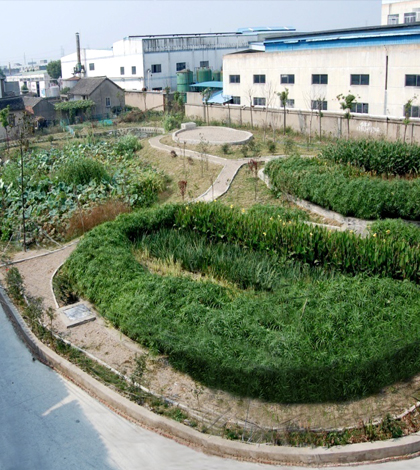Constructed wetland improves water quality, flow of intensely polluted urban river

If you don’t remember the moral of Aesop’s fable regarding the city mouse and his country-dwelling cousin, that’s okay — neither does the rest of the human race. As of 2008, more than half of the world’s population lives in an urban setting.
The population shift from rural to urban areas is changing the way people live, work and play, but it’s also having an overwhelming impact on the environment. Massive metropolises such as New York City, Mumbai and Sao Paulo are locked in a constant struggle to manage the garbage, wastewater and particulate emissions from their millions of residents, while also supporting growth and industry.
The city of Suzhou in eastern China may not be as large as the aforementioned urban centers, but the Zhijiashe River flowing through the city’s historic Luzhi Town region was incredibly polluted nonetheless. Waste from nearby homes and factories dumped directly into the river, bringing flow velocity to a near-standstill.
“Especially in the eastern and southern regions of China, many urban rivers are modified and polluted,” said Haifeng Jia, director of the Center for Urban Runoff Control and Stream Restoration at Tsinghua University in Beijing. “Some urban rivers have become blocked, leading to very low or no water flow.”
In an attempt to improve water quality and restore streamflow in the Zhijiashe, a team of researchers from Tsinghua University built a miniature wetland in the heart of Luzhi Town. The results of their work were published online in Ecological Engineering.
The Zhijiashe River had previously failed to even earn a Grade V, the government-mandated minimum requirement for a strictly scenic river (for reference, water from rivers designated as Grade VI is considered unusable for any purpose). While effluent can be managed through careful filtration and pumping, unwanted nutrients in the water are more difficult to remove. Natural wetlands are known to possess exceptional nutrient reduction properties, but often occur over acres, if not miles. The research team built one with a much smaller footprint: 76 meters by 41 meters.

Constructing the wetlands. (Credit: Haifeng Jia)
Each of the constructed wetland’s four stages employs a different substrate composition and various plant species. Water is first pumped from the river and into the rapid filtration stage, where sand and gravel help remove particulate matter. From there, the water moves through a heavily planted down-flow subsurface wetland and its up-flow counterpart, respectively containing five and six layers of sediment. The brunt of the filtration occurs in these two stages, where biological, chemical and physical processes assisted by plant roots enable a biological membrane to form, cleansing the water as it passes through.
The final stage, the surface flow wetland, further improves water quality as nutrients are absorbed by plants, consumed by microbes or settle into the wetland sediment. At last, Jia says, the filtered water is pumped into a blocked branch of the Zhijiashe.
Although the wetland was a feat of engineering in itself, the $70,000 spent on its construction — not counting the cost of land acquisition — would be squandered if the system didn’t produce results. Between May 2011 and June 2012, the researchers sampled the water at several points in the system once per week. Their monitoring efforts revealed that the wetlands were quite effective in removing nutrients from the water: On average, the wetland system reduced phosphorus loads by about 60 percent and nitrogen loads by 70 percent. Furthermore, the researchers saw significantly increased flow velocity in the Zhijiashe River.
“In the beginning,” Jia said, there were “a few local people who did not understand our work.” Though those folks made “some troubles” for the researchers, local attitudes toward the project, as with the river itself, seem to have improved.
Before the wetlands were built, Jia said it was rare to see anyone around the waterfront. But now, “we are glad that there are always a lot of people walking and playing [near] the wetland,” he said.
Top image: Completed wetlands. (Credit: Haifeng Jia)




Yao HR
November 26, 2014 at 3:44 am
good!